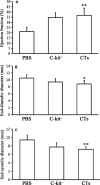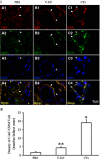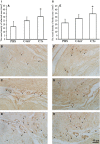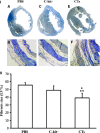Intramyocardial transplantation of cardiac telocytes decreases myocardial infarction and improves post-infarcted cardiac function in rats
- PMID: 24655344
- PMCID: PMC4119384
- DOI: 10.1111/jcmm.12259
Intramyocardial transplantation of cardiac telocytes decreases myocardial infarction and improves post-infarcted cardiac function in rats
Abstract
The midterm effects of cardiac telocytes (CTs) transplantation on myocardial infarction (MI) and the cellular mechanisms involved in the beneficial effects of CTs transplantation are not understood. In the present study, we have revealed that transplantation of CTs was able to significantly decrease the infarct size and improved cardiac function 14 weeks after MI. It has established that CT transplantation exerted a protective effect on the myocardium and this was maintained for at least 14 weeks. The cellular mechanism behind this beneficial effect on MI was partially attributed to increased cardiac angiogenesis, improved reconstruction of the CT network and decreased myocardial fibrosis. These combined effects decreased the infarct size, improved the reconstruction of the LV and enhanced myocardial function in MI. Our findings suggest that CTs could be considered as a potential cell source for therapeutic use to improve cardiac repair and function following MI, used either alone or in tandem with stem cells.
Keywords: cardiac telocytes; myocardial infarction; post-infarction cardiac function.
© 2014 The Authors. Journal of Cellular and Molecular Medicine published by John Wiley & Sons Ltd and Foundation for Cellular and Molecular Medicine.
Figures







References
-
- Bernstein HS, Srivastava D. Stem cell therapy for cardiac disease. Pediatr Res. 2012;71:491–9. - PubMed
-
- Ptaszek LM, Mansour M, Ruskin JN, et al. Towards regenerative therapy for cardiac disease. Lancet. 2012;10–16:933–42. - PubMed
-
- Segers VF, Lee RT. Stem-cell therapy for cardiac disease. Nature. 2008;451:937–42. - PubMed
-
- Assmus B, Schachinger V, Teupe C, et al. Transplantation of progenitor cells and regeneration enhancement in acute myocardial infarction (TOPCARE-AMI) Circulation. 2002;106:3009–17. - PubMed
Publication types
MeSH terms
Substances
LinkOut - more resources
Full Text Sources
Other Literature Sources
Medical
Research Materials

